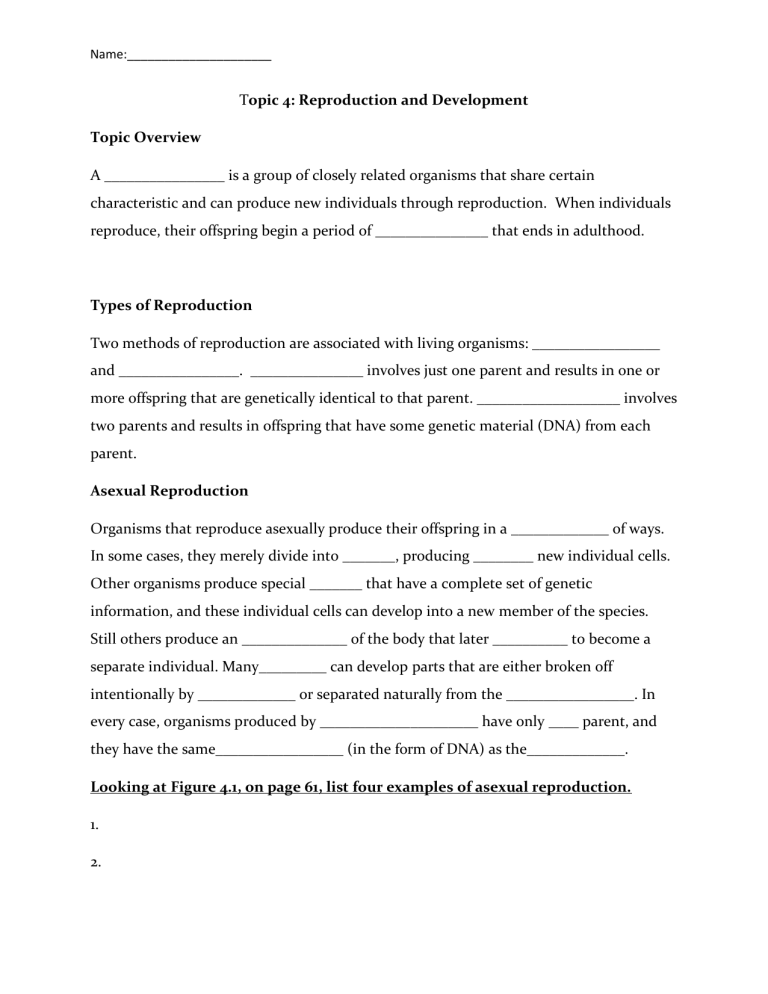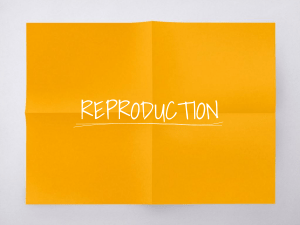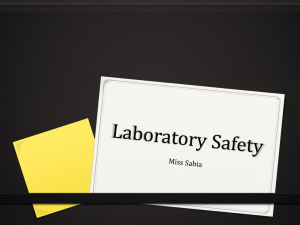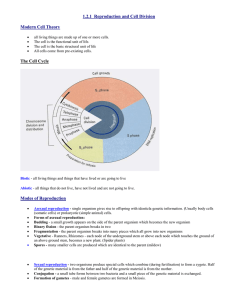
Name:_____________________ Topic 4: Reproduction and Development Topic Overview A ________________ is a group of closely related organisms that share certain characteristic and can produce new individuals through reproduction. When individuals reproduce, their offspring begin a period of _______________ that ends in adulthood. Types of Reproduction Two methods of reproduction are associated with living organisms: _________________ and ________________. _______________ involves just one parent and results in one or more offspring that are genetically identical to that parent. ___________________ involves two parents and results in offspring that have some genetic material (DNA) from each parent. Asexual Reproduction Organisms that reproduce asexually produce their offspring in a _____________ of ways. In some cases, they merely divide into _______, producing ________ new individual cells. Other organisms produce special _______ that have a complete set of genetic information, and these individual cells can develop into a new member of the species. Still others produce an ______________ of the body that later __________ to become a separate individual. Many_________ can develop parts that are either broken off intentionally by _____________ or separated naturally from the _________________. In every case, organisms produced by _____________________ have only ____ parent, and they have the same_________________ (in the form of DNA) as the_____________. Looking at Figure 4.1, on page 61, list four examples of asexual reproduction. 1. 2. Name:_____________________ 3. 4. Which statement best describes the process of asexual reproduction? 1. It involves two parents. 2. It requires the combination of sperm and egg. 3. It results in variation in the offspring. 4. It involves the production of genetic copies. Sexual Reproduction In____________________, offspring receive half of their genes from one parent and half of the other. The genes are carried on _____________________ in ________________(also known as gametes or egg or sperm cells), which join in ___________________. Each parent supplies half of the genetic information needed to form a complete individual. The __________, which is the sex cell from the _____________, provides half of the information; the ________, which is the sex cell from the _____________, provides the other half. _____________ produced by sexual reproduction combine__________ inherited from each parent’s _____________. Since an offspring gets only half of its _________ from each parent, it will not be _____________ to either of its parents. Also, since each _______________ gets an unique combination of ___________ from its parents, it will differ from its______________ (brothers and sisters). Compared to the offspring of sexual reproduction in animals, the offspring of asexual reproduction will 1. show greater variety 2. be more resistant to disease 3. be genetically identical to the parent Name:_____________________ 4. grow larger Cloning ___________ is a technique that accomplishes the same end results as ____________________. It’s a way of making identical ____________________. Recently, it has been possible to produce clones of animals that ordinarily only reproduce_____________. This is done by inserting a ____________ from a “parent” organism’s cell (one that has a complete set of genetic information from that individual) into an ________ cell from which the _____________ has been removed. The result is an ______ that now contains not 50%, but _________ of the genetic information from a single parent. Which statement concerning an organism produced by cloning is correct? 1. The clone is genetically identified to its parent. 2. The clone has the combined genes of both of its parents. 3. The genetic makeup of the clone will be somewhat different from each of its parents. 4. The appearance of the clone will be entirely different from that of its parents. Cell Division _____________ is the orderly separation of one cell into two. Before a ______ divides, the _____________ information in the ________ of the ________ is _______________ exactly. The process, by which a cell’s genetic material divides, creating two complete sets of the cell’s genetic material, known as _____________. ______________ provides two cells that each have a full set of identical __________ and ________________ (unless a mutation occurs somewhere along the way). Name:_____________________ During _____________, one copy of ____________ information is distributed to each new ________. As a result, each new ______ has all the information it needs to ___________ properly. One-celled _______________ make use of ___________ for _________________________. Multicellular organisms mainly use ______________ for growth and for cell _____________________________. A second type of cell division is ________________. This process ____________ the genetic material in a way that results in the _______________ of __________ cells. Each ______________ has only __________ the genetic material needed for a cell to function properly. Organisms that produce asexually usually do so by a form of cell division called 1. meiosis 2. mitosis 3. gamete formation 4. sperm formation Mitotic Division/Mitosis During the process of ____________________________, the double-stranded chromosomes that are visible during _____________ split into two identical single strands and move apart to opposite ends of the cell. In the space below, draw figure 4.3 on page 63 Name:_____________________ The process concludes when the _____________divides, resulting in two smaller, but genetically ____________, cells. The process of mitotic cell division normally results in the production of 1. four cells with half the number of chromosomes as the parent 2. two cells with the same number of chromosomes as the parent 3. two cells with only one chromosome from each parent 4. one cell with a replicated set of matched chromosomes Meiotic Division/Meiosis The ________________(sperm and egg) formed during ____________ cell division have only one half of the organisms ____________________________—only one ____________ of each pair that is present in the body __________ of that organism. However, a full set of _______________information is needed to produce a complete individual. When __________ and _______ combine during ___________________, all of the newly paired _________________ and all of the required genetic information are present in the _______________________. Meiotic _____________ begins with a body cell that has the _________________ of chromosomes typical of the species. Depending on the species, the cell contains one or more pairs of _______________ that determine the___________ of the organism. During the first phase of _____________________, the double-stranded chromosomes line up in pairs in the center of the cell. The two ________________of each pair (still doublestranded) then separate, moving to opposite ends of the cell. Following this separation, the _____________________ physically to form_____________________. The second phase involves the _______________ of each of these two new cells. This time, however, the _________________ line up in a single file line in the center of each ______. Each ________________ consists of two strands. The strands ____________ and move to opposite ends of each of the ____________________.When the process is complete, Name:_____________________ ______________ are formed, each having _________ the number of __________________ of the organism’s body ________. Each contains only _____ member of each original ___________________. Meiotic division in females involves the ___________ number of _____________ and ____________ changes as in males. The division of _____________ is where the two differ. The _____________ in a cell destined to become an _______ divides unequally, resulting in one ________________ and three small nonfunctioning _____________. Meiosis as a Source of Variation The events that occur during _____________ do more than simply divide______________ into smaller sets and form smaller cells. ______________ is responsible for much of the ____________ variation among the ______________ of each individual. For example, the two members of each pair of __________________ carry different ways of expressing many of the ____________ traits, so the way the different pairs ______________ line up in relation to other pairs leads to many possible ________________ in the ______________ that result. Another way _____________ can arise is by the exchange of ________________ which occurs as they pair up during the first ______________. This process is sometimes called__________________. Each time a _________ and _________ combine, a unique combination of ________________________ results. Zygote Formation During fertilization, the gametes unite (join together) to form a ____________—a cell that contains all the genetic information needed by the offspring. This process is known as _________________, since the genes from both parents recombine when ______________ Name:_____________________ occurs. Since a sex cell contains a unique combination of ______________ material, the result of the random combination of any ________ and _______ explains the variation found in ______________ produced by ______________________. This variation plays a key role in the ________________ change and species__________________. The ___________ contains all the information necessary for ___________, _____________, and eventual _________________ of the organism. The zygote____________ by ________ to form a _______________ organism. In the space below, draw figure 4.10 on page 67 An exact duplication of the complete set of chromosomes of a cell, followed by the separation of these duplicate sets into two new cells, is known as 1. mitotic cell division 2. zygote formation 3. meiotic cell division 4. Fertilization New cells are produced within the uterus as a direct result 1. gamete formation 2. meiotic cell division 3. mitotic cell division 4. ecological succession Early Development Name:_____________________ During the early stages of development, the cells that are formed by __________________ begin to undergo __________________, which simple means that they become different from one another. This leads to the ______________ of _____________________, which form the _____________, and then the __________ of _________________ organisms. In an _____________, an organism in an early stage of development, all the ____________ information in each cell starts out the same. However, different_________ are activated and ______________ in certain cells, causing them to make only some of the many _____________ they are capable of ________________. As a result, these _________ become different from others, and may develop into ____________, ____________, or any of the other specialized cells of the organism. The _____________ or ______________ of genes can be due to _______________________ from within the _______, from surrounding _______, or from ___________ the organism. When a gene is actively producing its protein, scientists say that the gene is _______________. There is much evidence that ______________________, which is the result of ____________________, can be modified through interaction with the __________________. Provide two examples of an environmentally produced gene modification Human Reproduction and Development __________________ and _______________ are carried out by specialized organs. The functions of these organs is regulated by ______________ from the ___________________. In humans, as in nearly all mammals, _________________ and ________________ occur internally—within the _____________ body. Reproductive ____________ in other mammals are similar in appearance and function. Female Reproductive System Name:_____________________ The human female reproductive system is organized to produce______________, to support internal ________________ and __________________, to exchange materials through the _____________ and provide ___________ to the offspring. In human females, the ____________ produce egg cells (female gametes) and the hormones _____________ and ______________. The hormones are associated with sexual ______________ and the _________________ process. The ovaries are located near the open ends of tubes called _______________ (egg ducts). The _______ cell can be fertilized in the _____________ if ______________ are present. The oviducts lead to the __________, where the _____________ develops into a _____________. After the fertilized egg sinks into the thickened wall of the _____________, a _______________ begins to form. The ______________ is the organ responsible for the passage (by diffusion) of nutrients and oxygen from the mother’s blood to the fetus. Wastes from the fetus also _____________ to the mother’s ________ through the placenta. During birth, the muscular ______________ undergoes a series of contractions that eventually push the ___________ out of the mother’s ____________. Table 4.2 The Function of the Parts of the Human Female Reproductive System Structure Ovary Oviduct Uterus Function Name:_____________________ Birth Canal (Vagina) Male Reproductive System The __________ of the male reproductive system are the organs that produce __________________. The testes also produce the hormone_________________, which is associated with male sexual development and ________________. Other structures associated with the male reproductive ______________ produce _____________ and ______________ that are needed for the proper function and delivery of male _____________ to the female _____________________. Hormone Regulation The male ______________________ and other male _________________, such as facial hair and deep voice, that develop as sexual maturity is reached are influenced by several ________________, including ________________ from the testes. The development of female reproductive system and female features, such as breast_____________ and widening of the __________, also involves several important ______________, such as ________________ and __________________. Once sexual maturity is reached, females begin a regular cycle of about _____ days, during which an ________ is released on about day ______. The timing of the events of this cycle is regulated by two hormones from the ____________, along with several others from an ____________ gland in the __________. Although the interactions of the hormone are quite complex,__________________ and _________________ play important roles in the female_____________________________. Name:_____________________ ________________ from the ovaries influences sexual development of ______________. Together, ________________ and ________________ influence the preparation of the lining of the ______________ so that a fertilized _________ that embeds itself there can develop normally. _________________ also maintains the uterine______________ throughout ________________. For this reason, _______________ is often called the hormone of ________________. At the end of the cycle, if the _____ is not _____________, the levels of_______________ and ________________ decrease, and the lining of the _____________ breaks down. Then the ____________ begins again. Human Development As with most other mammals, embryonic development begins in the _________________. During the first part of pregnancy, __________ continue to divide by _______________ division and begin to _______________, forming ______________ and _______________. The _______________and a fluid sac that cushions and protects the developing ____________ both form at this time, too. After about _____________, when all the major organs have begun to form, the embryo is called a ______________. During the first few months, when essential organs are forming in the ___________, things can go wrong. Problems associated with either the embryo's _______________ genes or the mother’s exposure to various harmful ___________________ factors can affect the embryo. Harmful environmental factors woman should avoid at any time during pregnancy include _____________, ___________, and ________________. Ise of these can lead to the birth of a baby with ______________, ________________________, and/or low ____________________ and problems associated with it. An embyo or ___________ may also be harmed if the mother has a poor _________, is exposed to certain __________ substances, or gets certain _______________, such as German ______________ or ___________. After birth, cell ________________ and body ____________ continue until adulthood. During ____________, the structures of the ___________ slowly begin to age. Eventually, the organism _____________ and ___________. The process of _________, ___________, Name:_____________________ ____________, __________, and ____________ is a predictable pattern that applies not just to humans but to all _____________. Application of Reproductive Technology Recent discoveries by scientist have greatly changed the way we can deal with many problems involving the _______________ of humans as well as plants and other organisms. The knowledge we gained has a variety of ________________, _______________, and __________________________. In the field of agriculture, scientists have produced plants that are resistant to ___________, _________________, and even frost. Such altered plants can then be __________ to produce thousands of genetically identical ______________. Using ______________________________, scientists can generate hundreds of offspring from one farm animal. In the field of ecology, ______________________ is being used to help build up populations of ___________________________. Embryos from endangered species have been __________________ into related species, who later give birth to offspring that are no different than they would be if they developed in the ___________ of endangered animals_______________. In the field of medicine, recent scientist discoveries have led to new ways of dealing with __________________ problems in humans, other _______________ and _____________. Some women cannot become _________________ because of problems with their _________________, _______________, or other parts of their _______________________. _____________________ have enabled doctors to help ____________ women become________________ by using ____________________ to adjust their hormones to normal levels. List 3 more examples of Reproductive Technology discussed on pages 71-21. Name:_____________________ Topic 4 Vocabulary asexual reproduction- a method of reproduction in which all the genes passed on to the offspring come from a single individual or parent cloning- a technique used to make identical organisms development- the process of change that occurs during an organism’s life to produce a more complex organism differentiation- the process that transforms developing cells into specialized cells with different structures and functions egg- a sex cell produced by a female embryo- an organism in the early stages of development (prior to birth) estrogen- a hormone (produced by the ovaries) that controls female and sexual development and the reproductive process expressed- the way that an unseen gene is seen in an organism as an actual physical trait fertilization- the process that combines a sperm cell and an egg cell fetus- the unborn, developing young of an animal during the later stages of development gamete-an egg or sperm cell; a sex cell gene expression- the result of activated genes meiosis- the process that results in the production of sex cells (egg and sperm) mitosis- the process that divides the cell’s nucleus into two, each with a complete set of genetic material from the parent cell. ovaries- the organ of the human female reproductive system that produces an egg cell, the female gamete Name:_____________________ placenta- the organ that enables nutrients and oxygen to pass from the mother’s blood to the fetus, and waste products to pass from the fetus to the mother progesterone- a human associated with sexual development and the reproductive system recombination- the additional mixing of genetic material from a sperm and egg which results in a unique combination of genes sex cell- an egg (female) or sperm (male) sexual reproduction- a method of reproduction that involves two parents to produce offspring species- a group of organisms that share certain characteristics and can mate with one another, producing fertile offspring sperm- the male sex cell testes- the male reproductive organ that produces sperm and the hormone testosterone testosterone- a hormone associated with male asexual development and reproduction uterus- the organ, in female animals, where the embryo develops into a fetus Name:_____________________ Topic 4 Review Questions 1. Write one or more paragraphs that compare the two methods of reproduction, asexual and sexual. You must include at least: • • • • One similarity between the two methods One difference between the two methods One example of an organism that reproduces by asexual reproduction One example of an organism that reproduces by sexual reproduction 2. Which characteristic of sexual reproduction has specifically favored the survival of animals that live on land? A. Fusion of gametes in the outside environment B. Male gametes that may be carried by the wind C. Fertilization within the body of the female D. Female gametes that develop within ovaries 3. The nucleus is removed from a body cell of one organism and is placed in an egg that has had its nucleus removed. This process, which results in the production of organisms that are genetically alike, is known as A. Cloning B. Fertilization C. Biological adaptation D. DNA production 4. “Dolly” is a sheep developed from an egg cell of her mother that had its nucleus replaced by a nucleus from a body cell of her mother. As a result of this technique, Dolly is A. No longer available to reproduce B. Genetically identical to her mother C. Able to have a longer lifespan D. Unable to mate 5. Which phase does not describe cells cloned from a carrot? Name:_____________________ A. B. C. D. They are genetically identical They are produced sexually They have the same DNA codes They have identical chromosomes 6. Compare asexual reproduction to sexual reproduction. In your comparison, be sure to include: A. Which type of reproduction results in offspring that are usually genetically identical to the previous generation and explain why this occurs B. One other way these methods of reproduction differ 7. A. B. C. D. Cloning an individual usually produces organisms that Contain dangerous mutations Contain identical genes Are identical in appearance and behavior Produce enzymes different from the parent 8. A variation causes the production of an improved variety of apple. What is the best method to use to obtain additional apple trees of this variety in the shortest period of time? A. Selective breeding B. Natural selection C. Asexual reproduction D. Hormone therapy 9. Kangaroos are mammals that lack a placenta. Therefore, they must have an alternate way of supplying the developing embryo with A. Nutrients B. Enzymes C. Carbon dioxide D. Genetic information Name:_____________________ 10. Which statement best explains the significance of meiosis in the evolution of a species? A. Meiosis produces egg and sperm that are alike B. Meiosis provides form chromosomal variation in the gametes produced by the organism C. Equal numbers of eggs are sperm are produced by meiosis D. The gametes produced by meiosis ensure the continuation of any particular species by asexual reproduction 11. Most cells in the body of a fruit fly contain eight chromosomes. In some cells, only four chromosomes are present, a condition which is a direct result of A. Mitotic cell division B. Meiotic cell division C. Embryonic differentiation D. Internal fertilization 12. Meiosis and fertilization are important processes because they may most immediately result in A. Many body B. Genetic variation C. Immune responses D. Natural selection 13. The great variety of possible gene combinations in a sexually reproducing species is due part to the A. Sorting of genes as a result of gene replication B. Pairing of genes as a result of mitosis C. Pairing of genes as a result of differentiation D. Sorting of genes as a result of meiosis 14. Compared to human cells resulting from mitotic cell division, human cells resulting from meiotic cell division would have A. Twice as many chromosomes B. The same number of chromosomes C. One half the number of chromosomes D. One-quarter as many chromosomes Name:_____________________ 15. Which statement is true of both mitosis and meiosis? A. Both are involved in asexual reproduction B. Both occur only in reproductive cells C. The number of chromosomes is reduced by half D. DNA replication occurs before the division of the nucleus 16. Down syndrome is a genetic disorder caused by the presence of an extra chromosome in the body cells of humans. This extra chromosome occurs in a gamete as a result of A. An error in the process of cloning B. An error in meiotic cell division C. A gene mutation D. Replication of a single chromosome during mitosis 17. Most mammals have adaptions for A. Internal fertilization and internal development of the fetus B. Internal fertilization and external development of the fetus C. External fertilization and external development of the fetus D. External fertilization and internal development of the fetus 18. A human zygote is produced from gametes that are usually identified as A. The expression of encoded information B. The number of altered genes C. Chromosome number D. Cell size 19. The human brain, kidney, and liver all develop from the same zygote. This fact indicates that cells formed by divisions of the zygote are able to A. Differentiate B. Undergo cloning C. Mutate D. Be fertilized 20. As certain species has little genetic variation. The rapid extinction of this species would most likely result from the effect of A. Successful cloning B. Gene manipulation Name:_____________________ C. Environmental change D. Genetic recombination 21. Sexual reproduction in a species usually results in A. An increase in the chromosome number in the offspring B. Offspring genetically identically to the parent C. Recombination of genes D. A decrease in biodiversity 22. Which hormone does not directly regulate human reproductive cycles A. Testosterone B. Insulin C. Estrogen D. Progesterone 23. Which structure is correctly paired with its function A. Ovary—provides milk for newborns B. Testis—development of sperm C. Placenta—storage of released eggs D. Uterus—produces estrogen 24. Which process normally occurs at the placenta A. Oxygen diffuses from fetal blood to material blood B. Materials are exchanged between fetal and maternal blood C. Maternal blood is converted into fetal blood D. Digestive enzymes pass from maternal blood into fetal blood Name:_____________________






